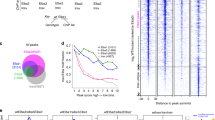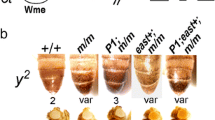Abstract
Chromatin domain insulators are thought to insulate adjacent genes, including their regulatory elements, from each other by organizing chromatin into functionally independent domains. Thus insulators should play a global role in gene regulation by keeping regulatory domains separated. However, this has never been demonstrated. We previously designed and characterized a transgene that is under GAL4 UAS control and encodes a dominant-negative form of the Boundary Element-Associated Factors BEAF-32A and BEAF-32B. The BID transgene encodes the BEAF self-interaction domain but lacks a DNA binding domain. Expression of BID in eye imaginal discs leads to a rough eye phenotype. Here we screen for dominant mutations that modify this eye phenotype. This assay provides evidence for cross-talk between different classes of insulators, and for a broad role of the BEAF proteins in maintaining patterns of gene expression during eye development. Most identified genes encode other insulator binding proteins, transcription factors involved in head development, or general transcription factors. Because it is unlikely that insulator function is limited to eye development, the present results support the hypothesis that insulators play a widespread role in maintaining global transcription programs.





Similar content being viewed by others
References
Armstrong JA, Sperling AS, Deuring R, Manning L, Moseley SL, Papoulas O, Piatek CI, Doe CQ, Tamkun JW (2005) Genetic screens for enhancers of brahma reveal functional interactions between the BRM chromatin-remodeling complex and the delta-notch signal transduction pathway in Drosophila. Genetics 170:1761–1774
Aulner N, Monod C, Mandicourt G, Jullien D, Cuvier O, Sall A, Janssen S, Laemmli UK, Kas E (2002) The AT-hook protein D1 is essential for Drosophila melanogaster development and is implicated in position-effect variegation. Mol Cell Biol 22:1218–1232
Blanton J, Gaszner M, Schedl P (2003) Protein:protein interactions and the pairing of boundary elements in vivo. Genes Dev 17:664–675
Brand AH, Perrimon N (1993) Targeted gene expression as a means of altering cell fates and generating dominant phenotypes. Development 118:401–415
Cai H, Levine M (1995) Modulation of enhancer–promoter interactions by insulators in the Drosophila embryo. Nature 376:533–536
Campuzano S (2001) Emc, a negative HLH regulator with multiple functions in Drosophila development. Oncogene 20:8299–8307
Capelson M, Corces VG (2004) Boundary elements and nuclear organization. Biol Cell 96:617–629
Capelson M, Corces VG (2005) The ubiquitin ligase dTopors directs the nuclear organization of a chromatin insulator. Mol Cell 20:105–116
Cuvier O, Hart CM, Laemmli UK (1998) Identification of a class of chromatin boundary elements. Mol Cell Biol 18:7478–7486
Cuvier O, Hart CM, Kas E, Laemmli UK (2002) Identification of a multicopy chromatin boundary element at the borders of silenced chromosomal domains. Chromosoma 110:519–531
Denell R (1994) Discovery and genetic definition of the Drosophila Antennapedia complex. Genetics 138:549–552
Diederich RJ, Merrill VK, Pultz MA, Kaufman TC (1989) Isolation, structure, and expression of labial, a homeotic gene of the Antennapedia complex involved in Drosophila head development. Genes Dev 3:399–414
Dong PD, Chu J, Panganiban G (2001) Proximodistal domain specification and interactions in developing Drosophila appendages. Development 128:2365–2372
Gaszner M, Vazquez J, Schedl P (1999) The Zw5 protein, a component of the scs chromatin domain boundary, is able to block enhancer–promoter interaction. Genes Dev 13:2098–2107
Gause M, Eissenberg JC, Macrae AF, Dorsett M, Misulovin Z, Dorsett D (2006) Nipped-A, the Tra1/TRRAP subunit of the Drosophila SAGA and Tip60 complexes, has multiple roles in Notch signaling during wing development. Mol Cell Biol 26:2347–2359
Gerasimova TI, Gdula DA, Gerasimov DV, Simonova O, Corces VG (1995) A Drosophila protein that imparts directionality on a chromatin insulator is an enhancer of position-effect variegation. Cell 82:587–597
Geyer PK, Clark I (2002) Protecting against promiscuity: the regulatory role of insulators. Cell Mol Life Sci 59:2112–2127
Geyer PK, Corces VG (1992) DNA position-specific repression of transcription by a Drosophila zinc finger protein. Genes Dev 6:1865–1873
Gilbert MK, Tan YY, Hart CM (2006) The Drosophila boundary element-associated factors BEAF-32A and BEAF-32B affect chromatin structure. Genetics 173:1365–1375
Giot L, Bader JS, Brouwer C, Chaudhuri A, Kuang B, Li Y, Hao YL, Ooi CE, Godwin B, Vitols E, Vijayadamodar G, Pochart P, Machineni H, Welsh M, Kong Y, Zerhusen B, Malcolm R, Varrone Z, Collis A, Minto M, Burgess S, McDaniel L, Stimpson E, Spriggs F, Williams J, Neurath K, Ioime N, Agee M, Voss E, Furtak K, Renzulli R, Aanensen N, Carrolla S, Bickelhaupt E, Lazovatsky Y, DaSilva A, Zhong J, Stanyon CA, Finley RL Jr, White KP, Braverman M, Jarvie T, Gold S, Leach M, Knight J, Shimkets RA, McKenna MP, Chant J, Rothberg JM (2003) A protein interaction map of Drosophila melanogaster. Science 302:1727–1736
Greenberg AJ, Yanowitz JL, Schedl P (2004) The Drosophila GAGA factor is required for dosage compensation in males and for the formation of the male-specific-lethal complex chromatin entry site at 12DE. Genetics 166:279–289
Han Z, Li X, Wu J, Olson EN (2004) A myocardin-related transcription factor regulates activity of serum response factor in Drosophila. Proc Natl Acad Sci USA 101:12567–12572
Hart CM, Zhao K, Laemmli UK (1997) The scs’ boundary element: characterization of boundary element-associated factors. Mol Cell Biol 17:999–1009
Hart CM, Cuvier O, Laemmli UK (1999) Evidence for an antagonistic relationship between the boundary element-associated factor BEAF and the transcription factor DREF. Chromosoma 108:375–383
Janody F, Martirosyan Z, Benlali A, Treisman JE (2003) Two subunits of the Drosophila mediator complex act together to control cell affinity. Development 130:3691–3701
Kellum R, Schedl P (1991) A position-effect assay for boundaries of higher order chromosomal domains. Cell 64:941–950
Kennerdell JR, Yamaguchi S, Carthew RW (2002) RNAi is activated during Drosophila oocyte maturation in a manner dependent on aubergine and spindle-E. Genes Dev 16:1884–1889
Kermekchiev M, Pettersson M, Matthias P, Schaffner W (1991) Every enhancer works with every promoter for all the combinations tested: could new regulatory pathways evolve by enhancer shuffling? Gene Expr 1:71–81
Kuhn EJ, Geyer PK (2003) Genomic insulators: connecting properties to mechanism. Curr Opin Cell Biol 15:259–265
Labrador M, Corces VG (2002) Setting the boundaries of chromatin domains and nuclear organization. Cell 111:151–154
Lee TI, Causton HC, Holstege FC, Shen WC, Hannett N, Jennings EG, Winston F, Green MR, Young RA (2000) Redundant roles for the TFIID and SAGA complexes in global transcription. Nature 405:701–704
Lei EP, Corces VG (2006) RNA interference machinery influences the nuclear organization of a chromatin insulator. Nat Genet 38:936–941
Lewis EB (1998) The bithorax complex: the first fifty years. Int J Dev Biol 42:403–415
Litt MD, Simpson M, Gaszner M, Allis CD, Felsenfeld G (2001) Correlation between histone lysine methylation and developmental changes at the chicken beta-globin locus. Science 293:2453–2455
Maeda RK, Karch F (2006) The ABC of the BX-C: the bithorax complex explained. Development 133:1413–1422
Mukhopadhyay R, Yu W, Whitehead J, Xu J, Lezcano M, Pack S, Kanduri C, Kanduri M, Ginjala V, Vostrov A, Quitschke W, Chernukhin I, Klenova E, Lobanenkov V, Ohlsson R (2004) The binding sites for the chromatin insulator protein CTCF map to DNA methylation-free domains genome-wide. Genome Res 14:1594–1602
Mulholland NM, King IF, Kingston RE (2003) Regulation of Polycomb group complexes by the sequence-specific DNA binding proteins Zeste and GAGA. Genes Dev 17:2741–2746
Noma K, Allis CD, Grewal SI (2001) Transitions in distinct histone H3 methylation patterns at the heterochromatin domain boundaries. Science 293:1150–1155
Norton JD, Deed RW, Craggs G, Sablitzky F (1998) Id helix-loop-helix proteins in cell growth and differentiation. Trends Cell Biol 8:58–65
Ohtsuki S, Levine M (1998) GAGA mediates the enhancer blocking activity of the eve promoter in the Drosophila embryo. Genes Dev 12:3325–3330
Pal-Bhadra M, Leibovitch BA, Gandhi SG, Rao M, Bhadra U, Birchler JA, Elgin SC (2004) Heterochromatic silencing and HP1 localization in Drosophila are dependent on the RNAi machinery. Science 303:669–672
Prioleau MN, Nony P, Simpson M, Felsenfeld G (1999) An insulator element and condensed chromatin region separate the chicken beta-globin locus from an independently regulated erythroid-specific folate receptor gene. EMBO J 18:4035–4048
Read D, Butte MJ, Dernburg AF, Frasch M, Kornberg TB (2000) Functional studies of the BTB domain in the Drosophila GAGA and Mod(mdg4) proteins. Nucleic Acids Res 28:3864–3870
Recillas-Targa F, Pikaart MJ, Burgess-Beusse B, Bell AC, Litt MD, West AG, Gaszner M, Felsenfeld G (2002) Position-effect protection and enhancer blocking by the chicken beta-globin insulator are separable activities. Proc Natl Acad Sci USA 99:6883–6888
Rodriguez Alfageme C, Rudkin GT, Cohen LH (1980) Isolation, properties and cellular distribution of D1, a chromosomal protein of Drosophila. Chromosoma 78:1–31
Schwartz CJ, Sampson HM, Hlousek D, Percival-Smith A, Copeland JW, Simmonds AJ, Krause HM (2001) FTZ-Factor1 and Fushi tarazu interact via conserved nuclear receptor and coactivator motifs. EMBO J 20:510–519
Scott KS, Geyer PK (1995) Effects of the su(Hw) insulator protein on the expression of the divergently transcribed Drosophila yolk protein genes. EMBO J 14:6258–6267
Thomas BJ, Wassarman DA (1999) A fly’s eye view of biology. Trends Genet 15:184–190
Tsukiyama T, Becker PB, Wu C (1994) ATP-dependent nucleosome disruption at a heat-shock promoter mediated by binding of GAGA transcription factor. Nature 367:525–532
West AG, Gaszner M, Felsenfeld G (2002) Insulators: many functions, many mechanisms. Genes Dev 16:271–288
Yamaguchi M, Yoshida H, Hirose F, Inoue YH, Hayashi Y, Yamagishi M, Nishi Y, Tamai K, Sakaguchi K, Matsukage A (2001) Ectopic expression of BEAF32A in the Drosophila eye imaginal disc inhibits differentiation of photoreceptor cells and induces apoptosis. Chromosoma 110:313–321
Zhao K, Hart CM, Laemmli UK (1995) Visualization of chromosomal domains with boundary element-associated factor BEAF-32. Cell 81:879–889
Acknowledgments
We thank Cindy Henk and Ying Xiao of the Socolofsky Microscopy Center for assistance with the SEM; Matt Gilbert and Nan Jiang for comments on the manuscript; and Christal DeCuir-Charbonnet for assistance with the deficiency crosses. MRTF flies were kindly provided by Z. Han and E.N. Olson (University of Texas Southwestern Medical Center) and ftz flies were kindly provided by H.M. Krause (University of Toronto). This work was supported by grants from the Louisiana Board of Regents [LEQSF(2002-04)-RD-A-06 and LEQSF(2004-05)-RD-A-11] and a LSU Faculty Research Grant.
Author information
Authors and Affiliations
Corresponding author
Additional information
Communicated by G. Reuter.
Electronic supplementary material
Rights and permissions
About this article
Cite this article
Roy, S., Tan, Y.Y. & Hart, C.M. A genetic screen supports a broad role for the Drosophila insulator proteins BEAF-32A and BEAF-32B in maintaining patterns of gene expression. Mol Genet Genomics 277, 273–286 (2007). https://doi.org/10.1007/s00438-006-0187-8
Received:
Accepted:
Published:
Issue Date:
DOI: https://doi.org/10.1007/s00438-006-0187-8




